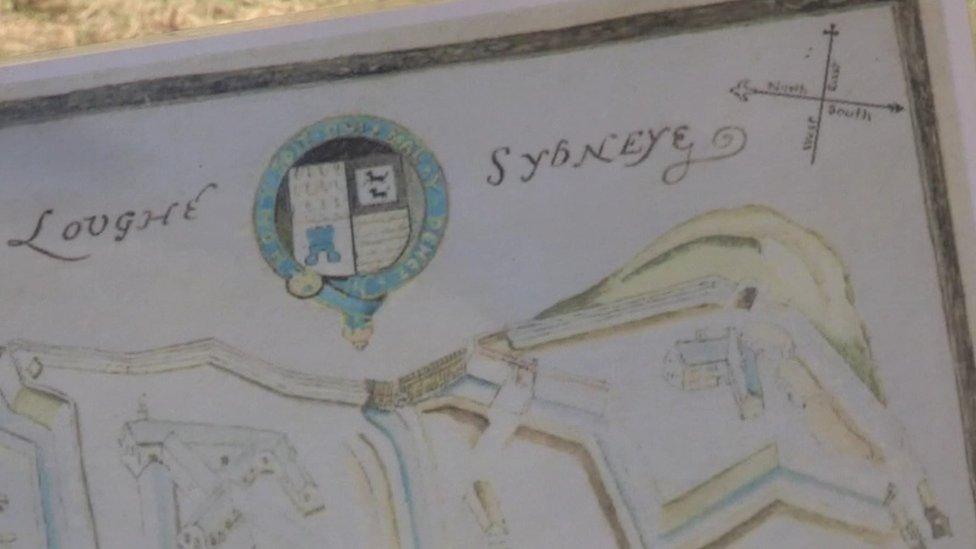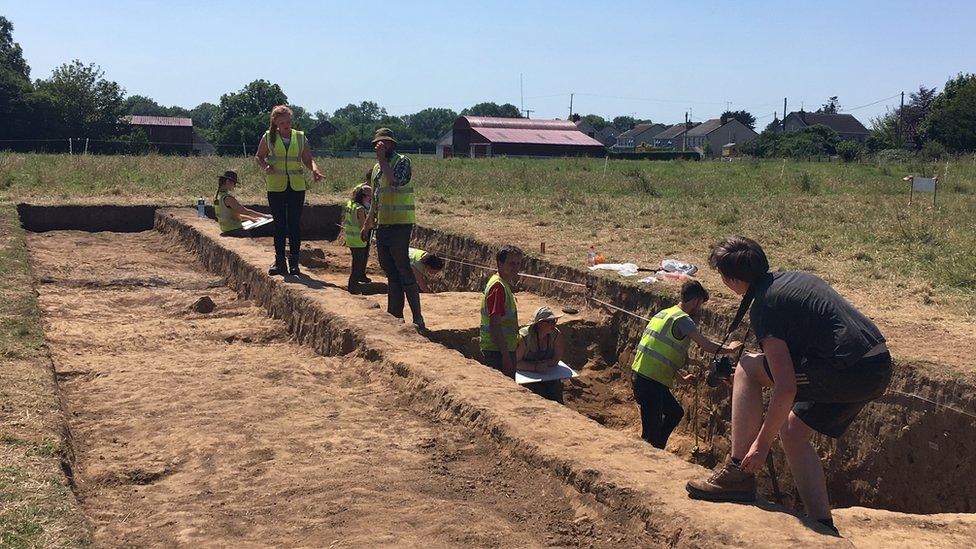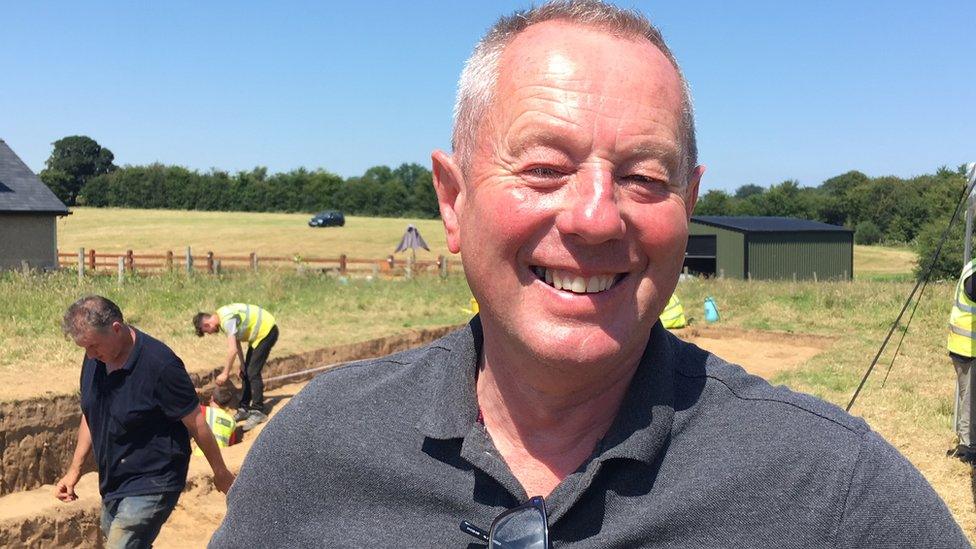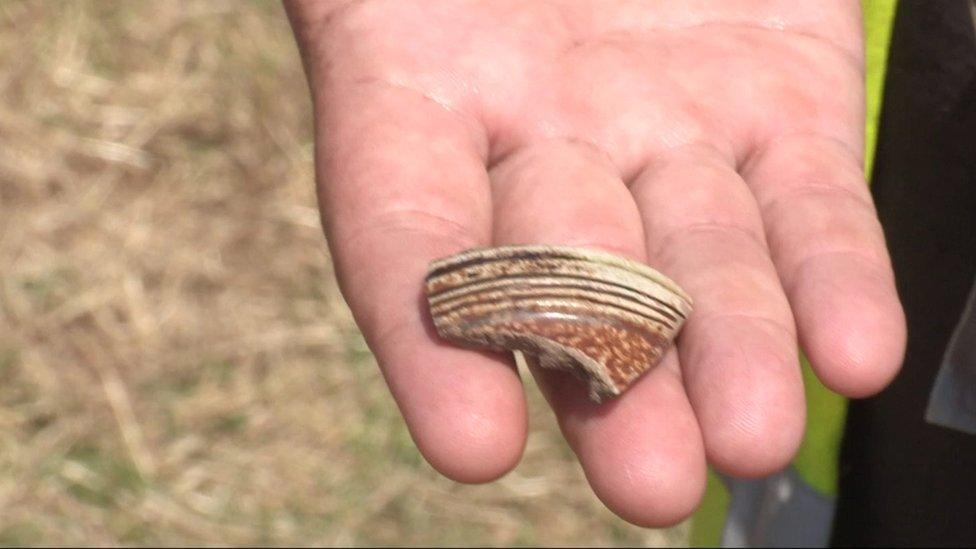Mountjoy fort rediscovered during County Tyrone dig
- Published
Archaeologists work at the site in County Tyrone
Archaeologists have rediscovered a fort from four centuries ago which had disappeared beneath the surface of what used to be the shoreline of Lough Neagh.
Students from Queen's University in Belfast have taken part in the dig at Brockagh in County Tyrone over the past month.
Evidence of a settlement going back thousands of years has also been found.
The dig was commissioned by the Lough Neagh Landscape Partnership.
It had support from the Heritage Lottery Fund.

The maps of royal cartographer Richard Bartlett, who documented Ireland in the early 17th century, had indicated there was a fort in the area
Mountjoy fort was built as the Tudor military campaign encroached on the territory of Hugh O'Neill, Earl of Ulster, towards the end of the Nine Years' War. The site was strategically significant.
"Bartlett in the early 1600s is going around mapping out what existed here, so we've a wonderful map of the period," said Liam Campbell, built and cultural officer with the Partnership.
"Richard Bartlett's map shows a fort here and we know that there are between 1000 and 1200 soldiers mustered here.
"And yet nothing remains on the surface of this place now."

The dig has been taking place over the past month
Lough Neagh, known as Lough Sydney in the early 17th century, used to lap the bottom of a cliff face just 100m or so from where the fort would have been.
But the lowering of water levels over the century has left the site almost four times as far from the water's edge now.
"If you take all of Ulster, Lough Neagh is like the hub of a bicycle wheel and all went out from around it," Mr Campbell said.
"So, this place might look peripheral, but it was really, really central.

Liam Campbell of the Lough Neagh Landscape Partnership said the project would help reconnect people with their past
"We're on the historical lough shore - this was a major source of food and protein, so people are actually here hunting, gathering and fishing.
"So it's no surprise these were centres of population and settlement for a very, very long time."
The dig has confirmed that the history goes back far beyond the 17th century fort, evident in geo-physical surveys carried out before the work started.
Meosilithic period
The archaeologists explored between three and four metres down, finding not only evidence of the fort, but of a settlement going back thousands of years.
"We've excavated everything manually, and we have uncovered a considerable ditch running across our trench," said Ruairí Ó Baoill, an archaeologist with Queen's University Belfast.

A blade thought to be 7,500 years old has been discovered
"In that ditch is 16th century pottery, fragments of rotary querns for grinding corn, red brick, Gaelic Irish pottery, bits of [Victorian] clay pipe and we're very happy," he added.
"Everywhere we've dug we've found archaeology.
"Elsewhere in the trenches we've found material dating back thousands of years - 7500 years to the end of the period of the first hunter-gatherer settlers, the Mesolithic period, and we've found their flints.
"We've found 6000-year-old flints, projectile heads and knives from the time of the first farmers.
"They're all living here, all in County Tyrone, all on the shores of Lough Neagh and all exploiting the lough."

17th century imported German pottery has also been found at the site
The finds have included the blade of an implement probably used to cut meat, which is still sharp 7500 years after it was carved.
The entire site has been meticulously recorded and will be written up, so while the trenches have been filled in, the discoveries and the archaeology will still be available.
"Because the landscape has changed so much, it's got people really interested in their place," Mr Campbell said.
"And part of the reason we did this was not just to do archaeology for the sake of it, but actually to get people reconnected to their past."